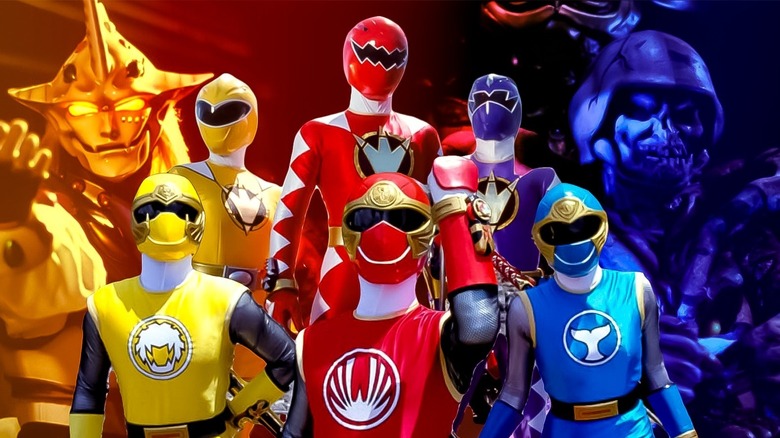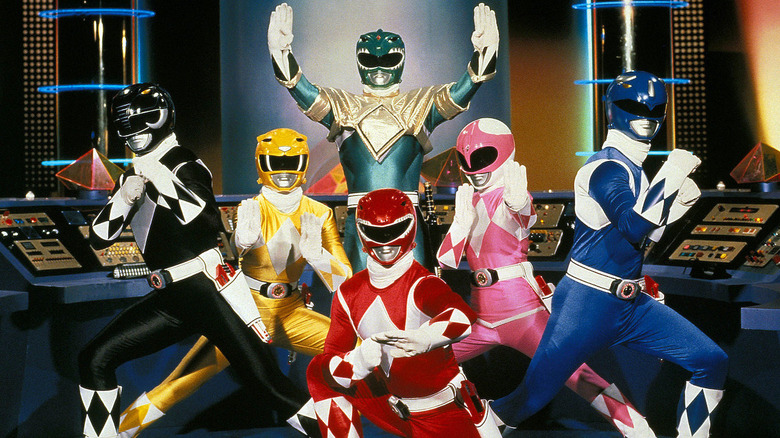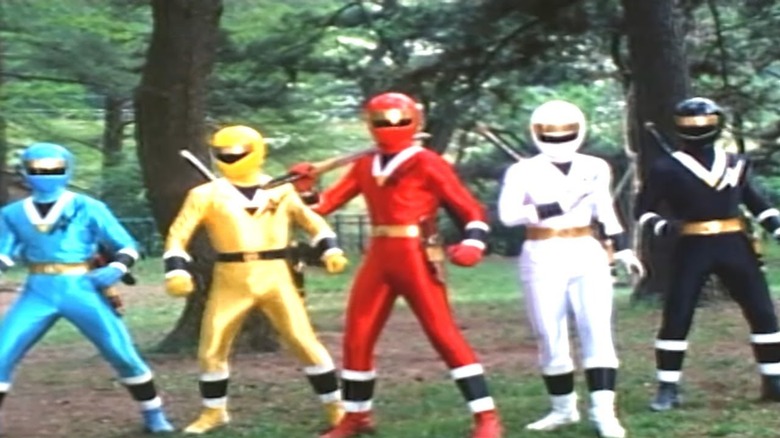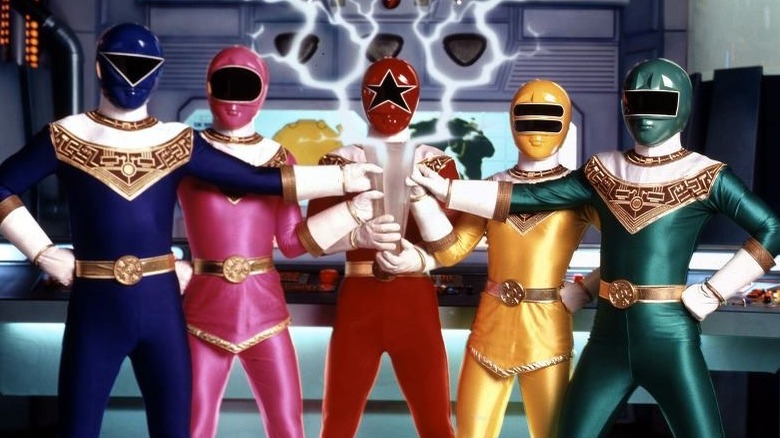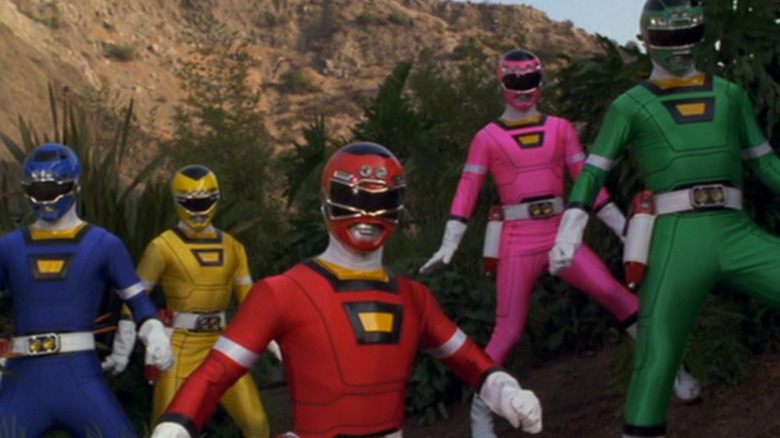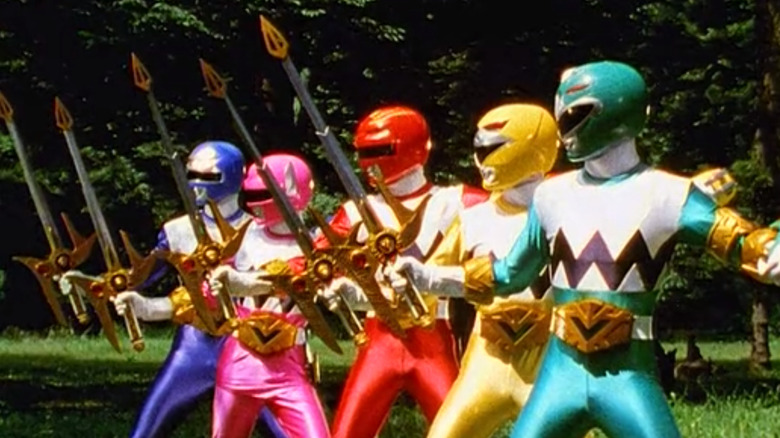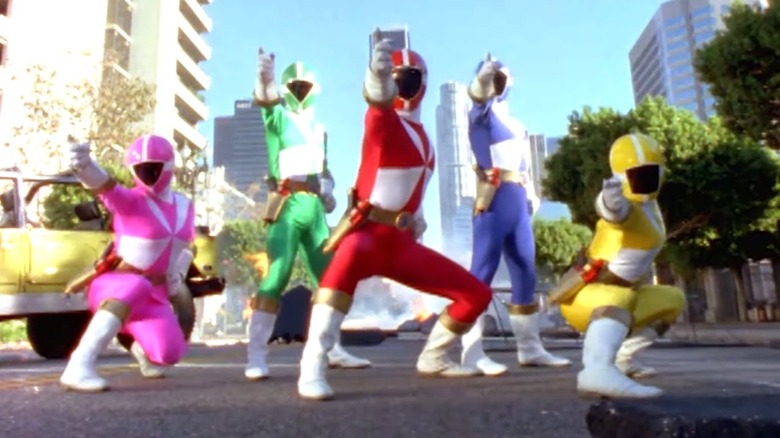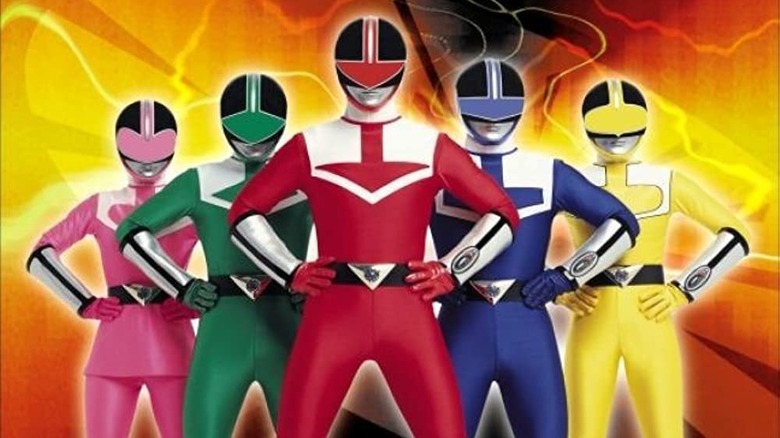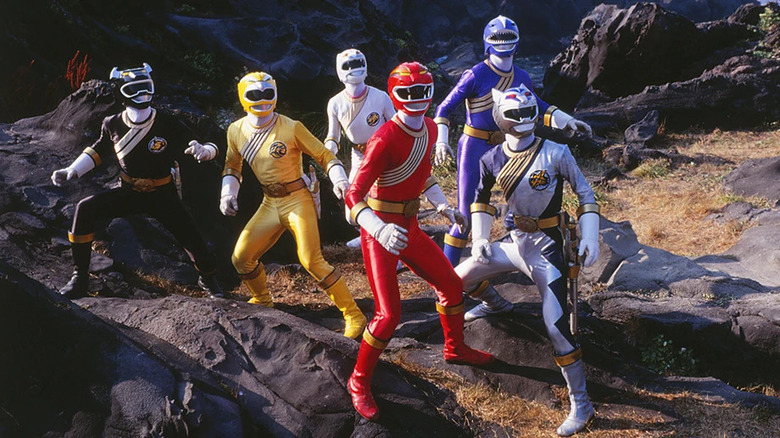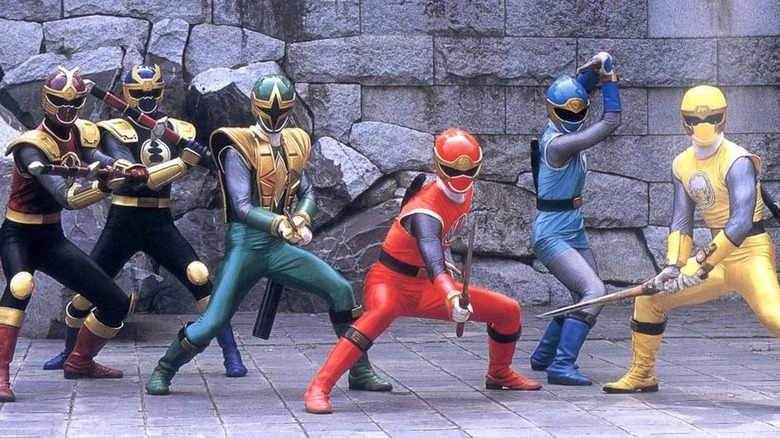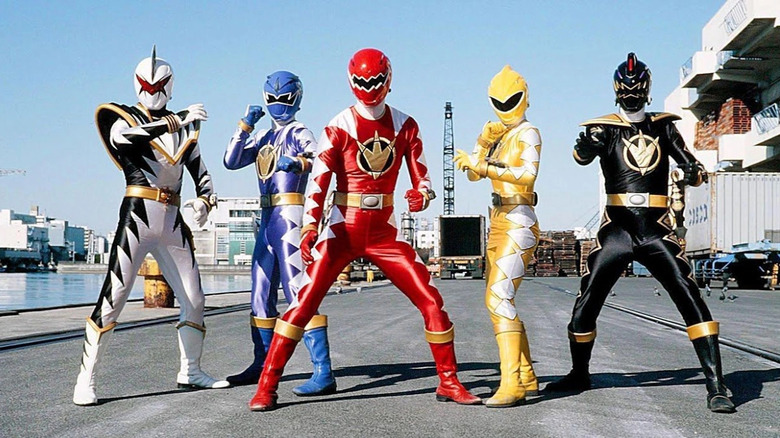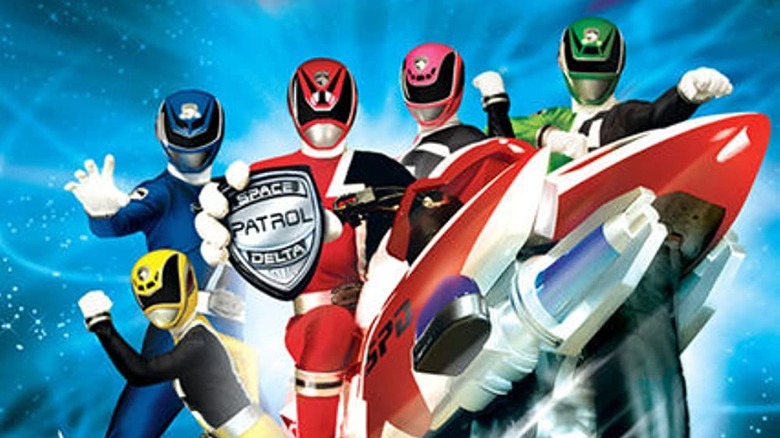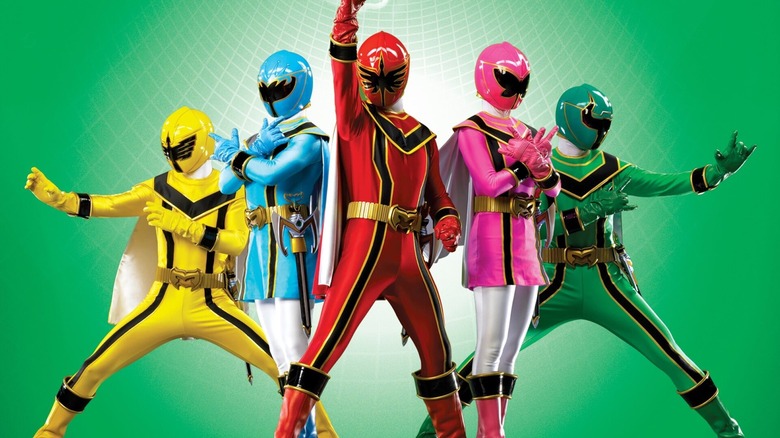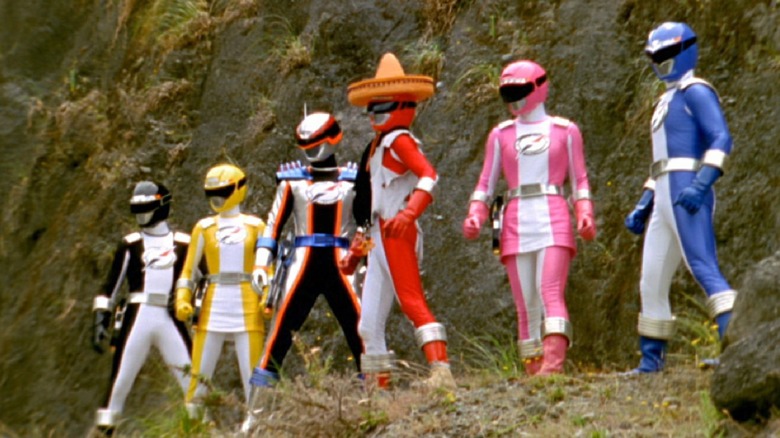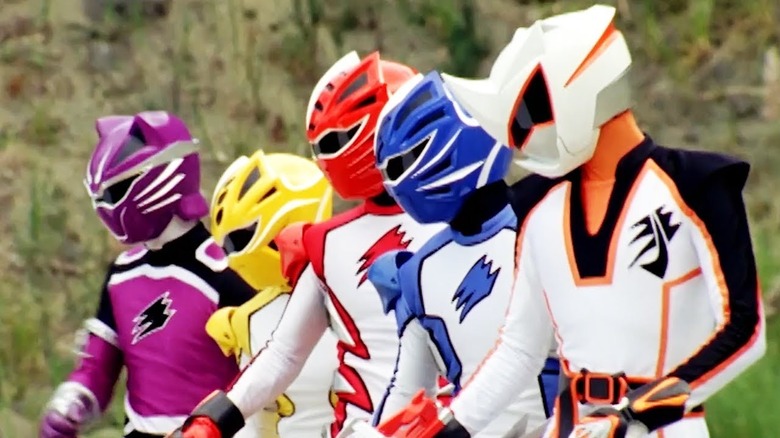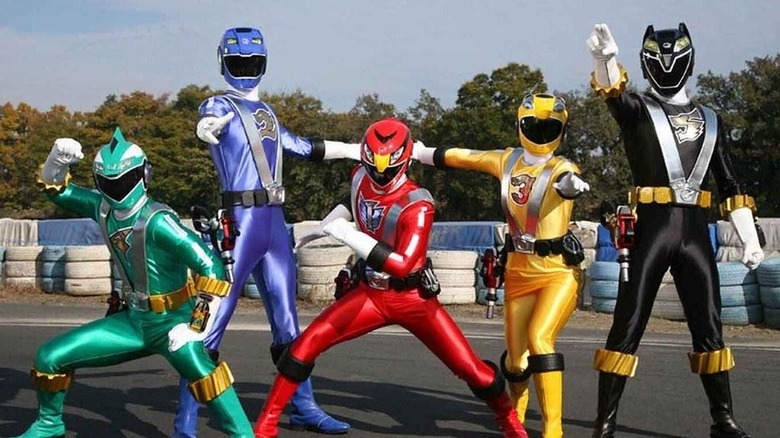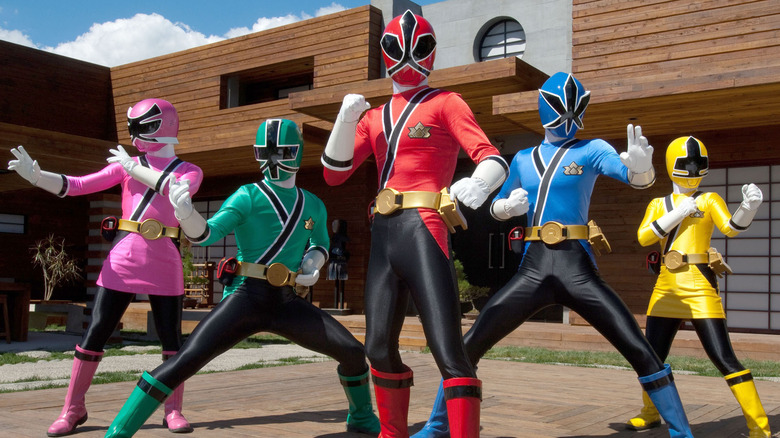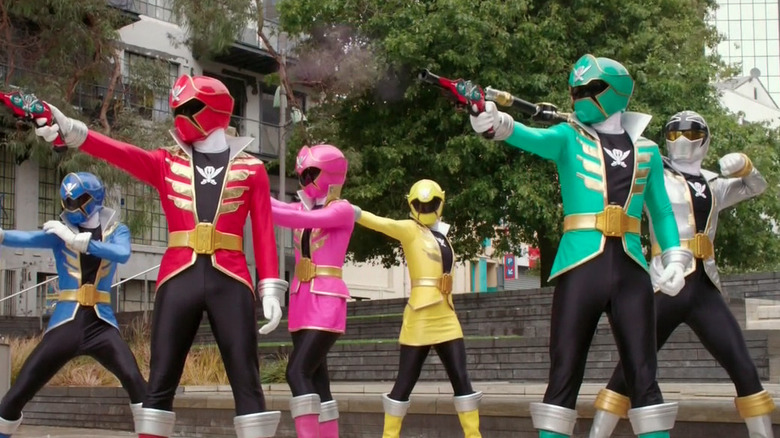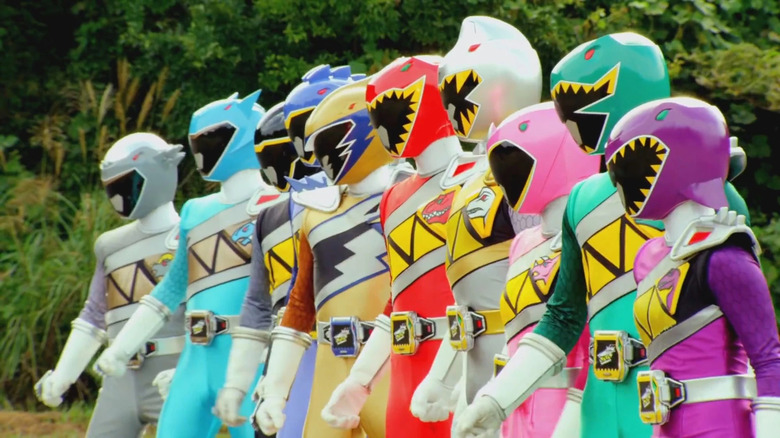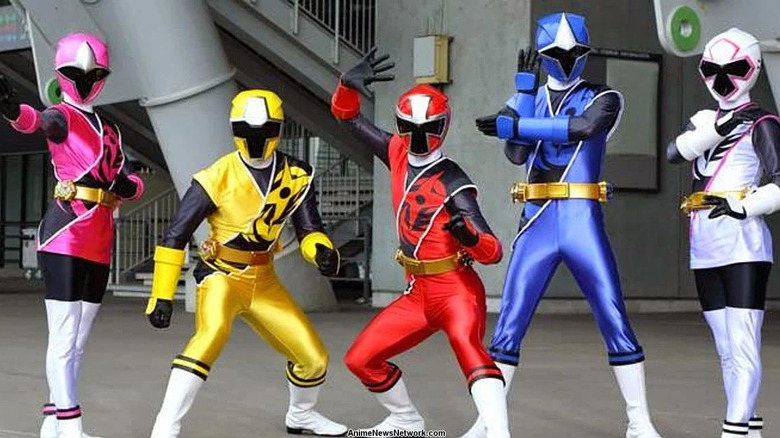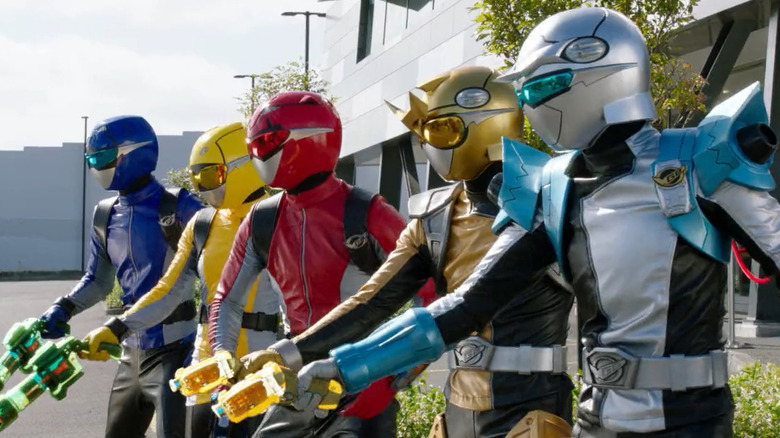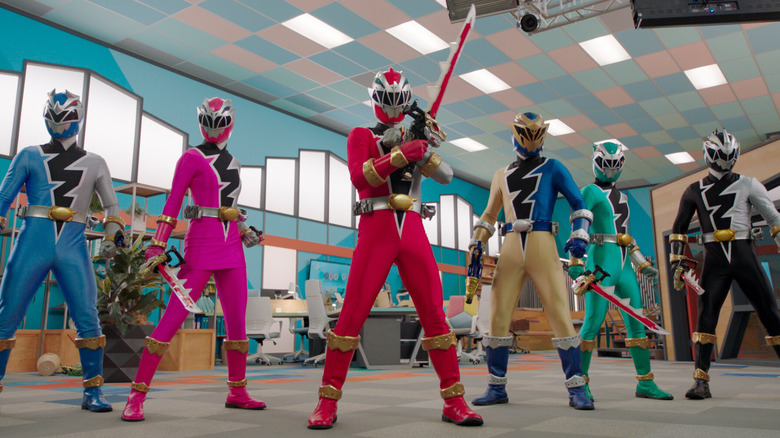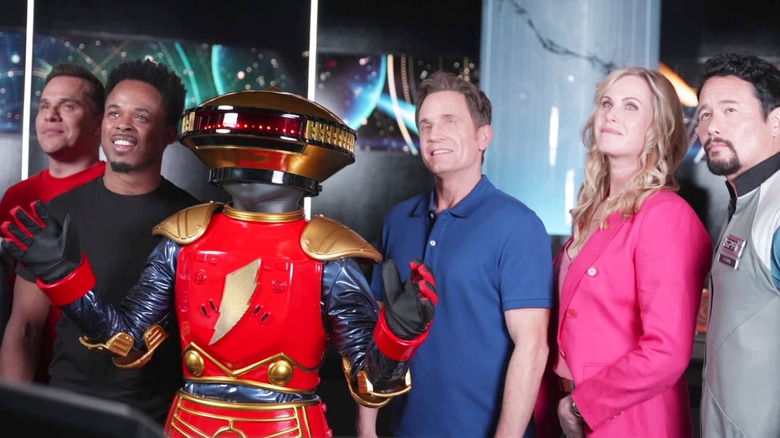Every Power Rangers Series Explained
There are few constants in children's entertainment, but one that has prevailed through thick and thin is the "Power Rangers" franchise. The series originated in Japan as the ongoing series "Super Sentai," which first aired in 1975. "Super Sentai" was later adapted for western audiences by Saban Entertainment, which pitched the series to Fox Kids with the idea to reuse footage from "Super Sentai" dubbed in English, inter-spliced with new footage of English-speaking actors. The resulting show spawned one of the biggest multimedia franchises of all time, spanning television shows, films, action figures, comic books, and video games.
Each season of the TV show follows a relatively similar format: Several teenagers or young adults are chosen by a mentor figure to morph into the multi-colored Power Rangers, sworn to protect Earth from supernatural threats. The Rangers are also able to pilot mechs known as Zords, which can combine with their fellow teammates under dire circumstances to form Megazords. It all began with "Mighty Morphin Power Rangers" in 1993. Since then, there have been over 20 different television series featuring various rotating teams of Power Rangers. Here's our explainer of every single season. Spoilers ahead.
Mighty Morphin Power Rangers
The Power Rangers team most '90s kids are familiar with hails from the first series, "Mighty Morphin Power Rangers," a pop culture phenomenon. The series debuted on Fox Kids in 1993, running for three seasons, with the first two consisting of the five original Rangers (Jason, Billy, Kimberly, Trini, and Zack) as well as the additional Green Ranger, Tommy, who joined about a third of the way into the first season. The Ninja Rangers replaced most of the original Rangers during the third season.
When the series begins, the Power Rangers are just five teenagers living in California. They are chosen by the wise, interdimensional being Zordon to become the Power Rangers and protect Earth from the villainous conqueror Rita Repulsa. Tommy comes into the picture after Rita brainwashes him and transforms him into the evil Green Ranger, but he's eventually turned good and joins the Power Rangers against the sorceress.
The original series has a problematic past that cannot be ignored — David Yost, who plays Billy the Blue Ranger, was subjected to on-set homophobic abuse, and the racial coding of the Rangers is deeply uncomfortable. Yet, "Mighty Morphin Power Rangers" is considered by many fans to be the best "Power Ranger" series, thanks in part to a nostalgic love for the franchise's simple beginnings.
Mighty Morphin Alien Rangers
Following the end of "Mighty Morphin Power Rangers," the series' story was briefly continued in a 10-episode miniseries, "Mighty Morphin Alien Rangers," which aired on Fox Kids in 1996. The original Rangers, along with everybody else on Earth, have been turned into children by Master Vile, the father of Rita Repulsa. As a result, Zordon is forced to summon five aliens from the planet Aquitar to become the Alien Rangers.
While "Mighty Morphin Alien Rangers" serves as a bridge between "Mighty Morphin Power Rangers" and the fourth season, "Power Rangers Zeo," it essentially works as an extended ending to the original series. As such, it isn't really considered to be a series of its own, despite featuring its own assembled team of unique Rangers. The miniseries heavily features David Yost, as his character Billy is the first to return to his regular age and effectively becomes the leader of the Alien Rangers.
Although the Alien Rangers remain an oft-forgotten team in the "Power Rangers" timeline, they return in later seasons, as it soon became tradition for "Power Rangers" series to annually bring back former teams to join forces with current groups in special episodes.
Power Rangers Zeo
"Power Rangers Zeo" premiered in 1996, continuing the ongoing storyline from "Mighty Morphin Power Rangers" and "Mighty Morphin Alien Rangers." Following the Rangers' loss of power, they come across the Zeo Crystal, which transforms them into the Zeo Rangers. At this point, the group consists of Tommy and prior replacements Adam, Rocky, and Katherine, as well as new addition Tanya. They are then joined by Trey, a native of the planet Triforia who becomes the Gold Ranger (he later passes his mantle onto Jason, the original Red Ranger).
"Power Rangers Zeo" changed the formula, which was quite a risk for the franchise. As Fox exec Margaret Loesch told AP News ahead of the series' premiere, "We've been describing 'Power Rangers' as kind of a kids' soap opera," referring to the way soaps air for a long time with rotating casts and characters. This would eventually become the new formula of "Power Rangers," although the remaining cast members of "Mighty Morphin Power Rangers" wouldn't hang around for long.
Fans have fond memories of "Power Rangers Zeo" as a highlight of the franchise's so-called Zordon Era. However, "Power Rangers Zeo" also contains one of the most infamous episodes ever: 1996's "A Season to Remember," which confirmed that Tommy would eventually marry Katherine, the Pink Ranger, despite fans having a soft spot for Tommy's relationship with Kimberly in previous seasons.
Power Rangers Turbo
Prior to the fifth season of "Power Rangers," the franchise released a second feature film, which formally introduced the next iteration of the Power Rangers. 1997's "Turbo: A Power Rangers Movie" swapped out the franchise's beloved Zords for cars, which was a decision that perplexed a lot of fans. In general, the film felt a lot cheaper than 1995's "Mighty Morphin Power Rangers: The Movie."
The subsequent series, "Power Rangers Turbo," premiered on Fox Kids in 1997, shortly after the movie's release. The series finds the core group of Rangers (Tommy, Adam, Tanya, and Katherine) graduating from high school while resuming their roles as the Turbo Rangers. They are joined by the 12-year-old Justin, who is able to morph into a full-sized adult Blue Ranger. Around halfway through the series, however, the original Turbo Rangers pass on their powers to a new group of teens: T.J., Carlos, Ashley, and Cassie, who join Justin as the new Turbo Rangers.
"Power Rangers Turbo" is also notable for Zordon and Alpha-5 taking a backseat, as they depart for most of the series during the first episode. Zordon returns in the finale when he is captured by Divatox (a space pirate and the Turbo Rangers' primary antagonist), forcing the Turbo Rangers to launch a rescue mission.
Power Rangers in Space
"Power Rangers in Space," the sixth season, was the culmination of everything that had come before for the "Power Rangers" franchise. This team of Power Rangers consists of four of the former Turbo Rangers, who venture into space to rescue Zordon from the clutches of Dark Specter, an evil being who slowly drains their former mentor of his powers. The four are joined by Andros, a Red Space Ranger who is being hunted by Dark Specter.
Many fans see this climactic season of television as the point where "Power Rangers" truly blossomed as a franchise, with IGN claiming the series "showed that more mature storylines and bigger consequences could be tackled, way beyond the modus operandi of selling action figures to children." Notably, the season saw Zordon, the long-time parental figure to the Power Rangers, sacrifice himself to finally vanquish their enemies, including Dark Specter, Rita Repulsa, and Lord Zedd.
"Power Rangers in Space" is beloved by fans of the franchise and is often regarded as a potential end to the series if Saban didn't decide to continue rebooting it. The series isn't without its campier elements: The fourth episode, "Shell Shocked," is a crossover with the live-action "Teenage Mutant Ninja Turtles" series "Ninja Turtles: The Next Mutation." The two superhero teams find themselves at odds when Astronema, an underling of Dark Specter, brainwashes the turtles against the Rangers.
Power Rangers Lost Galaxy
"Power Rangers Lost Galaxy" is the first series to center on a new group of Power Rangers disconnected from the characters and events of previous seasons. It premiered in 1999 on Fox Kids, airing for one season with an entirely unique cast of characters. The series follows four young adults who, on an expedition to an Earth-like colony in space, discover the Quasar Sabers, which they pull from a stone and become the Galaxy Rangers in the process.
Throughout their adventures, the Galaxy Rangers end up facing many previous threats from the franchise, including the Psycho Rangers who were created during "Power Rangers in Space" — the Galaxy Rangers end up receiving backup from the Space Rangers themselves. Like "Power Rangers in Space," "Lost Galaxy" wasn't opposed to more serious narrative turns, such as the Pink Galaxy Ranger, Kendrix, being killed off while trying to save the Pink Space Ranger.
This narrative choice had some real-life basis, as Kendrix's actor, Valerie Vernon, had to leave the show to undergo leukemia treatment. Thankfully, her treatment was successful and she returned to the show for the season finale, when the Galaxy Rangers revived their fallen comrade. This heartwarming story aside, "Power Rangers Lost Galaxy" is seen as a poor installment, with fans criticizing the season's uninteresting characters, rushed pacing, and plot holes.
Power Rangers Lightspeed Rescue
Premiering on Fox Kids in 2000, "Power Rangers Lightspeed Rescue" brings the Rangers back to sunny California. It centers on the fictional town of Mariner Bay, which is terrorized by demons that have been released from a nearby tomb. Lightspeed Rescue is a government agency of Power Rangers formed by Captain Mitchell, consisting of five citizens, including Mitchell's own daughter, Dana, who becomes the Pink Ranger. In addition to the five Lightspeed Rangers, "Power Rangers Lightspeed Rescue" introduced the Titanium Ranger, who is actually the long lost son of Captain Mitchell and doesn't have a counterpart in the "Super Sentai" series. The Rangers from "Lost Galaxy" also make an appearance in this season's annual team-up episode.
Fans of the franchise felt that "Lightspeed Rescue" was a bit of a step-down in quality, despite attempts to make this season a return to form for the franchise. Among the positives is the fact that the Power Rangers in this series don't have secret identities, doing away with the anonymous superhero subplots that were a constant in many previous seasons. The main issue here is that "Power Rangers Lightspeed Rescue" simply lacks the memorable villains of the franchise's earliest seasons, and it suffers as a result.
Power Rangers Time Force
Premiering on Fox Kids in 2001, "Power Rangers Time Force" follows an already-established team of Power Rangers from the year 3000 who travel back to 2001 while hunting down Ransik, a criminal mutant who kills their original Red Ranger, Alex. This season plays with time travel tropes, with Alex returning to 2001 from the future after the Time Force Rangers have unknowingly altered history.
"Time Force" was the final "Power Rangers" series to be distributed by Saban Entertainment before the company was bought by Disney as part of an acquisition of Fox Family (later rebranded as ABC Family). Sadly, this buyout also meant that a planned "Power Rangers Time Force" movie never saw the light of day. On the plus side, "Time Force" was the first "Power Rangers" series to receive a Daytime Emmy nomination, which it got for outstanding sound mixing.
Many fans look back on "Power Rangers Time Force" fondly as the last installment from the glory days of the franchise. The series coincided with a resurgence in popularity thanks to a new generation discovering "Power Rangers" for the first time, resulting in some of the franchise's most memorable episodes.
Power Rangers Wild Force
"Power Rangers Wild Force" debuted in 2002 as the first "Power Rangers" series to be produced by Disney, airing on ABC Kids. The story has more environmental themes than previous seasons: It features one of the most memorable villains from the "Power Rangers" universe in Master Org, a monster created from human pollution. His goal is to resurrect an ancient wolf-like creature known as Zen-Aku.
Thankfully, the Power Rangers are there to save the day. This team is led by Cole, a young adult who was raised by a jungle tribe after his parents were killed by Master Org. Cole eventually discovers a turtle-shaped island in the sky, which is the home of the Wild Force Rangers and their Zords. He joins them as their Red Ranger in an effort to learn about his past and forge his own future.
"Power Rangers Wild Force" also contains one of the franchise's most notable episodes, "Forever Red," which aired in October 2022. The special sees Cole joining forces with every former Red Ranger, including the iconic Jason from "Mighty Morphin Power Rangers." In a retrospective on the episode, The Illuminerdi called it "a love letter to the show's ten-year history" but criticized its rushed pacing and poor special effects.
Power Rangers Ninja Storm
Dropping in 2003, "Power Rangers Ninja Storm" was the first "Power Rangers" series to be filmed in New Zealand, which would become the norm for future seasons. It centers on Shane, Tori, and Dustin, who are all students at the Wind Ninja Academy. They don the Ninja Morphers and become the Ninja Storm Rangers to protect their classmates and city, Blue Bay Harbor, from a former student gone rogue. The three are later joined by two Thunder Rangers, as well as the Green Samurai Ranger, who initially start out as antagonists but soon band together with the Ninja Storm Rangers to face their common enemy.
"Power Rangers Ninja Storm" is a low point in the franchise, containing some of the franchise's worst writing and tonal decisions. Due to the series' lack of showcasing of former "Power Rangers" cast members, as well as the acknowledgment of "Power Rangers" existing in the universe of "Ninja Storm," many fans consider the season to be a parody. The heroes are pretty bland, and so are the villains — Lothor seems more interested in cracking terrible jokes than defeating the Rangers.
Power Rangers Dino Thunder
"Power Rangers Dino Thunder" was a breath of fresh air for fans. It wisely brought back Jason David Frank as Tommy Oliver, one of the franchise's most iconic characters, in a prominent regular role. Tommy is now a paleontology professor in Reefside, California. He takes three students in detention to find Dino Gems, which transform them into the Dino Rangers. Together, they face the prehistoric villain Mesogog, who wishes to return Earth to the era where dinosaurs thrived. Along the way, our heroes recruit an additional White Dino Ranger: Trent, the son of Tommy's former lab partner Anton (who unwillingly becomes the human surrogate for Mesogog).
"Power Rangers Dino Thunder" stands out for its more realistic portrayal of teenagers. "Unlike 'Mighty Morphin,' they felt real. The teens didn't get along and actually hated each other at first," said Inverse after revisiting this underrated season in 2016. "This dynamic was a huge departure from previous years where the Power Rangers were already BFFs and formed tight bonds after a brief 22 minutes. The Reefside teens inevitably gel, but their bond is earned, making the Dino Thunder Rangers more authentic than any generation before or since."
Power Rangers S.P.D.
"Power Rangers S.P.D." turned "Power Rangers" into a police procedural for kids. It takes place in the year 2025, which, back in 2005, was imagined to be a highly advanced society. The plot centers on a future where humans and aliens co-exist — that is, until the invasion of the nefarious Emperor Gruumm. This results in Earth's first line of defense, the S.P.D. A-Squad, going missing. The series follows the B-Squad Rangers: Sky, Bridge, and Sydney, as well as reformed thieves Jack and Elizabeth.
Following on from "Dino Thunder," the B-Squad Rangers initially struggle to work together as a team due to their differences. Jack makes for a daring new protagonist for the "Power Rangers" franchise as a thief-turned-hero, with his storyline marking a big change in direction. In a shock twist, it turns out that the A-Squad actually defected to Gruumm's side and are working with the villain. And, in another surprise moment, Jack realizes his talents are better suited outside Space Patrol Delta and leaves his post in the finale.
Power Rangers Mystic Force
2006's "Power Rangers Mystic Force" takes place in the town of Briarwood, where five teenagers are recruited by the sorceress Udonna to become the Mystic Rangers. They are tasked with defending Earth from the evil Master of the Underworld and his army of minions. However, when Udonna loses her powers, the Rangers must step up as Earth's lone defenders.
In contrast to previous "Power Rangers" series, the Zords in this season aren't robotic mechs, but come from the Rangers using magic to morph into gigantic beasts, which originated from its "Super Sentai" counterpart. Unfortunately, the series doesn't have a lot of original ideas when it comes to incorporating magic into the world of "Power Rangers," falling back on tropes like magic wands and flying brooms. appearing.
Nevertheless, many hardcore "Power Rangers" fans consider "Mystic Force" to be an underrated season of the show due to its bold divergence from the typical "Power Rangers" aesthetic. For instance, this was the first and only season of "Power Rangers" to give its superhero team capes, even though this had already been done in the "Super Sentai" series back in the 1970s.
Power Rangers Operation Overdrive
"Power Rangers Operation Overdrive" features a somewhat typical story for the "Power Rangers" franchise. The season focuses on a group of five young citizens from the fictional city of San Angeles. They are chosen by billionaire archaeologist and explorer Andrew Hartford to possess the crown jewels of the Corona Aurora, turning them into the Overdrive Rangers. Unlike other seasons, however, "Operation Overdrive" finds the Power Rangers venturing across the globe during their efforts to protect Earth, rather than be confined to one town.
"Operation Overdrive" was the first season to retool HD footage from the "Super Sentai" series, though some of the quality was lost when said footage was scaled down to fit the show's 4:3 aspect ratio. It also boasts an interesting team-up episode: "Once a Ranger" sees the Overdrive Rangers teaming up with former Rangers to face Thrax, the son of Rita Repulsa and Lord Zedd. Sadly, the episode was memorable for all the wrong reasons, with Geek Tyrant calling it "a jumbled mess of actors that they could convince to make an appearance."
Power Rangers Jungle Fury
The sixteenth "Power Rangers" season, "Power Rangers Jungle Fury" returned the franchise to its martial arts-inspired roots, centering on the members of a secret kung fu clan known as the Order of the Claw. They are sworn to protect the Earth from Dai Shi, an evil spirit they've kept locked away for thousands of years. When Dai Shi escapes, the top three students band together with a pizza place owner and his former ally to become the Jungle Fury Rangers.
"Jungle Fury" is one of the more divisive entries in the "Power Rangers" franchise. Some fans took issue with the show's pacing and casting decisions, while others appreciated that this particular team of Power Rangers had a lot of lessons to learn in order to become the best versions of themselves. "Power Rangers Jungle Fury" was among the shows hit by the 2007-2008 Writers Guild Strike, which occurred during the season's production. Non-union workers took the reins for a time, which is likely why the season feels so uneven in places.
Power Rangers RPM
2009's "Power Rangers RPM" was the last season produced by Disney, which was reportedly receiving blowback from parents over the violence displayed in the show. Due to an agreement with the toy company Bandai, the Mouse House was obligated to make one more season, and execs put Eddie Guzelian ("Lilo & Stitch 2") in charge. According to Guzelian, he was told "to shoot for something that was ambitious," and that's exactly what he did.
The series follows the aftermath of a computer virus which takes over Earth and enslaves the population, resulting in the creation of a new Power Rangers team to defend humankind's last remaining city. Like previous seasons, the team initially consisted of the Red, Blue, and Yellow Rangers, with Green, Black, Gold, and Silver Rangers added as the season progressed.
Critics responded well to this storyline, appreciating its darker themes and more adult storylines. Disney, however, wanted nothing to do with it — at least, according to Guzelian. "I really can't explain Disney's attitude towards the show but I can definitely, from personal experience, attest [...] that they act ashamed to be producing it," he wrote on the "Power Rangers" fan board RangerCrew (via Inverse). One of the best seasons of the show ever created flew under the radar as a result.
Power Rangers Samurai
In 2010, "Power Rangers" was acquired by none other than Haim Saban, the franchise's creator. It moved to Nickelodeon for the 2011 series "Power Rangers Samurai," which would become the first iteration since "Mighty Morphin Power Rangers" to air for more than one season: "Power Rangers Super Samurai" followed in 2012. Saban went all out promoting the franchise's return to his care. The new Power Rangers made an appearance at the 84th Annual Macy's Thanksgiving Day Parade, and episodes of "Mighty Morphin Power Rangers" aired once a day leading up to the new season's premiere.
The series centers on Jayden, a Red Ranger of the Shiba Clan who forms a Power Rangers team on the advice of his mentor. The new group's job is to oppose the flooding of Earth by Master Xandred. Later, Jayden leaves his position as Red Ranger, with his sister Lauren replacing him. This storyline was criticized by fans who grew to like Jayden's character. "Power Rangers Samurai" also featured the return of the hapless bully Bulk in a recurring role, who is reunited with Skull — his partner in crime — in the finale. They have no impact on the plot whatsoever, but in terms of nostalgia value, their presence is a welcome one.
Power Rangers Megaforce
"Power Rangers" continued its run on Nickelodeon in 2013 with "Power Rangers Megaforce." Like the Samurai Rangers, the Megaforce Rangers debuted at the Macy's Thanksgiving Day Parade. They were joined by some former Rangers from the franchise, hinting at the direction the season would take: "Power Rangers Megaforce" featured many returning characters from the series' past.
The season sees a supernatural guardian of Earth named Gosei put together a new team after the Warstar Empire — the primary antagonists — plans an invasion of the planet. In the follow-up season, "Power Rangers Megaforce," the Megaforce Rangers get new Morphers that allow them to transform into Power Rangers from the past. Among the returning Rangers were Tommy from "Mighty Morphin Power Rangers," T.J. from "Power Rangers Turbo," Leo from "Power Rangers Lost Galaxy," and Dana from "Power Rangers Lightspeed Rescue."
Despite being a 20th anniversary celebration of "Power Rangers," some fans couldn't help but feel like "Megaforce" disappointed. The season was criticized for trying to adapt two seasons of "Super Sentai" at once, despite it making little sense from a storytelling perspective. Speaking to Den of Geek, story editor James W. Bates revealed that he was against this strategy and lamented how the season turned out, calling it "part of the process of limitations where I can't get everything I want."
Power Rangers Dino Charge
"Power Rangers Dino Charge" premiered on Nickelodeon in 2015 and aired for two seasons, with "Power Rangers Dino Super Charge" debuting the following year. After the debacle of "Megaforce," fans were keen for a series that brought the franchise back to its roots. "Dino Charge" delivered on this — both seasons were a joy to watch, with returning writer Judd Lynn coming up with the goods.
"Dino Charge" follows a group of teenagers who happen upon the Energems, remnants of an alien dinosaur named Keeper, who arrived on Earth 65 million years ago as an intergalactic refugee. As one would expect from a "Power Rangers" series, the Energems turn these oblivious teens into the Dino Force Rangers, tasked with finding the rest of the Energems and protecting Earth from Keeper's former enemies.
What's special about "Power Rangers Dino Charge" is that it features one of the largest core teams of Power Rangers ever, with ten total Rangers by the end. It also stands out for its long-overdue focus on a woman of color in Pink Ranger Shelby Watkins, as well as its commitment to having an extensive backstory. "Dino Charge" and "Dino Super Charge" put the franchise back on track in a big way.
Power Rangers Ninja Steel
"Power Rangers Ninja Steel" and "Power Rangers Super Ninja Steel" mark a bittersweet time in the franchise's history. The first season aired in 2017, the same year that the ill-fated big screen reboot bombed hard at the box office, killing plans for a new movie franchise. This led to Haim Saban once again selling the franchise, this time to Hasbro. As such, "Ninja Steel" was the last season produced by Saban.
That didn't stop "Power Rangers Ninja Steel" from being one of the most inventive seasons in the franchise's history. After being hunted by Galvanax, an intergalactic game show champion, the powerful Ninja Power Stars end up in the hands of several teenagers from Summer Cove. They transform into the Ninja Steel Rangers, angering Galvanax and making them his newest targets. They're later joined by Levi, a country singer who turns out to be the long lost older brother of Brody, the Red Ninja Steel Ranger.
To commemorate the 25th anniversary of "Power Rangers," Jason David Frank once again reprised his role as Tommy Oliver, donning his classic costume in the team-up episode "Dimensions in Danger." Unfortunately, this would be the final appearance of the character, as Frank tragically passed away in 2022.
Power Rangers Beast Morphers
The Hasbro-produced "Power Rangers Beast Morphers" aired on Nickelodeon for two seasons in 2019 and 2020. Rather than go in a completely new direction, "Beast Morphers" paid off plotlines established ten years prior in "Power Rangers RPM." The series takes place in the city of Coral Harbor, where scientists have perfected a renewable energy for the city in the form of Morph-X. This is combined with animal DNA by a clandestine agency called Grid Battleforce, and the result is the Beast Morphers, a new team of Power Rangers charged with protecting Coral Harbor from the sentient virus Evox.
It later transpires that Evox is actually Venjix, the villain of "RPM." Not only are these two seasons tied together in a way that nobody saw coming, but the new Rangers also cross paths with the heroes of "Power Rangers Dino Charge," and Jason, the original Red Ranger from "Mighty Morphin Power Rangers," even makes a memorable cameo. "Power Rangers Beast Morphers" went out of its way to satisfy fans who had become disillusioned by recent seasons, with the Dino Rangers team-up going down particularly well.
Power Rangers Dino Fury
The COVID-19 pandemic slowed down the entire entertainment industry, but the "Power Rangers" franchise was far from dormant during this time. In early 2021, the first season of "Power Rangers Dino Fury" debuted on Nickelodeon, the first "Power Rangers" series produced by Entertainment One after Hasbro acquired it in 2019. "Dino Fury" centers on an all-new team of Power Rangers. They inherit their powers from six ancient knights, who battled the Sporix Beasts (the central villains of "Dino Fury") 65 million years ago. The team includes Zayto and Aiyon, former Dino Fury Rangers who were frozen in stasis; Amelia, an investigative reporter who becomes the Pink Ranger; and Ollie, who assists his mother, Dr. Lani, with her archaeology expeditions.
After proving extremely popular, "Dino Fury" moved to Netflix for its second season, which allowed the writers to move away from the standalone episode formula. "When the show is destined for Netflix, where the mode of consumption is binge watching, as opposed to one episode dropping a week, the arguments that little kids can't remember what happens, week on week, becomes much less relevant," executive producer Simon Bennett told Den of Geek. "Serial threads are much more palatable now." The "Dino Fury" story will continue in "Power Rangers Cosmic Fury," the 30th season overall. It's set to drop on Netflix in late 2023.
Mighty Morphin Power Rangers: Once & Always
To celebrate "Power Rangers" having been on television for 30 years in 2023, some of the original "Mighty Morphin Power Rangers" cast members returned for a Netflix TV special, titled "Mighty Morphin Power Rangers: Once & Always." These returning characters include David Yost's Billy, Walter Emanuel Jones' Zack, and Catherine Sutherland's Kat, who appeared regularly in many of the early seasons of "Power Rangers." The reunion went down well with fans and critics alike, with USA Today calling it "millennial nostalgia done right."
In the special, the original Power Rangers are confronted with their former enemy, Rita Repulsa, who captures several of the Power Rangers (those played by actors who have passed away or declined to return). "Once & Always" contains many Easter eggs and references to the original series, such as Kat mentioning dangerous "pink energy," which alludes to an oft-quoted piece of dialogue from the "Mighty Morphin Power Rangers" episode "Wild West Rangers, Part II." The special proves that, no matter how dark it seems for the "Power Rangers" franchise, it will always hold a special place in the hearts of the fans and the actors who have helped keep it alive over the years.
